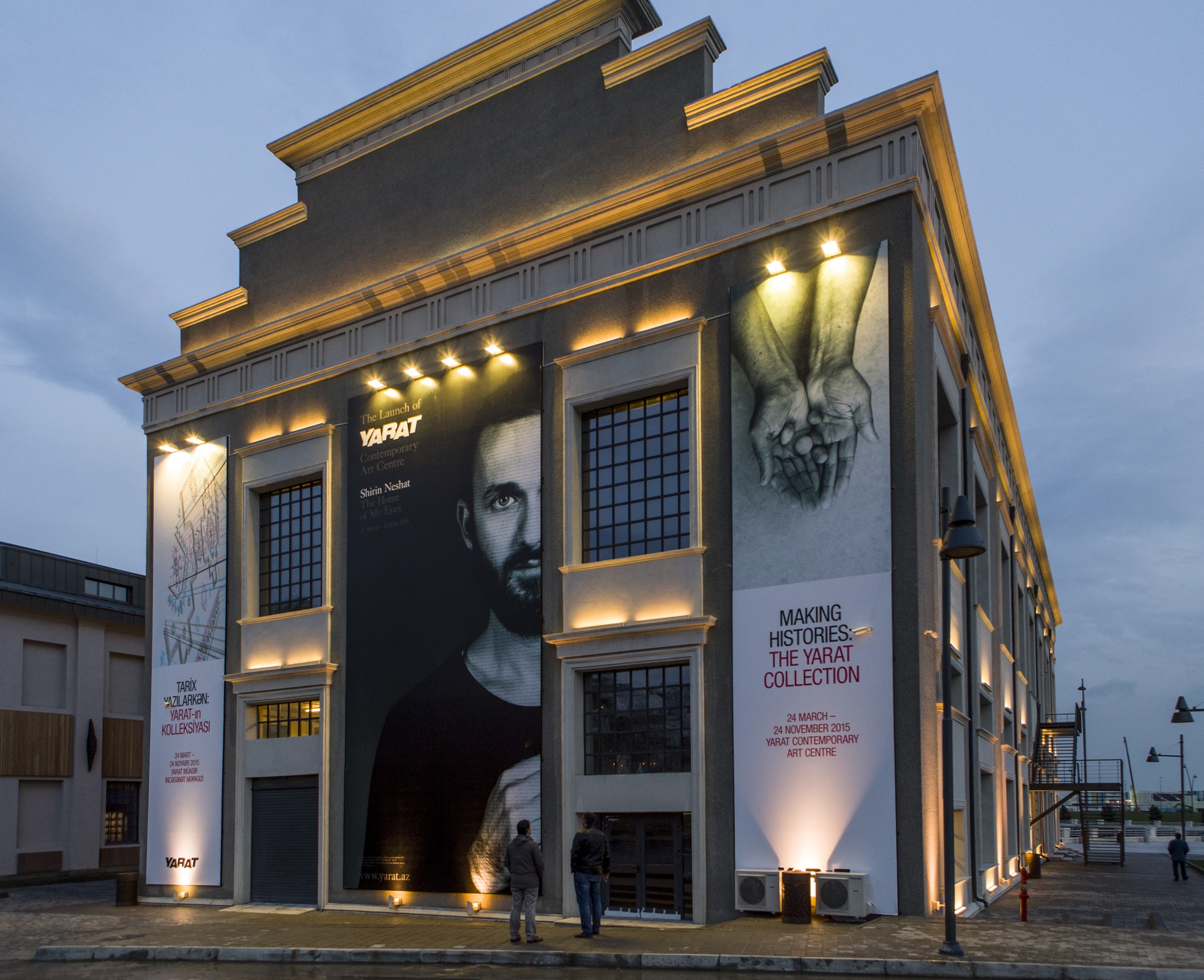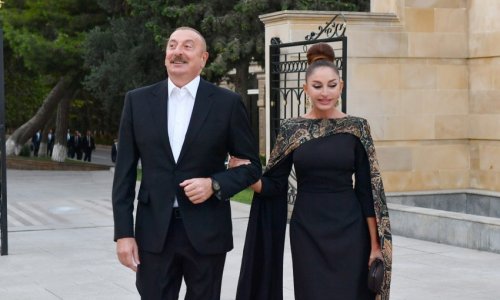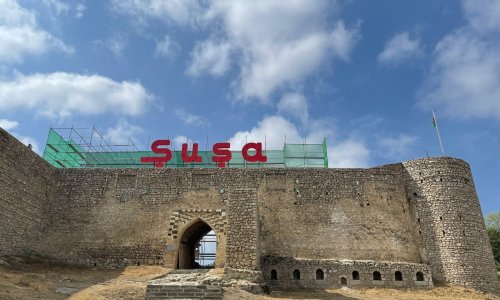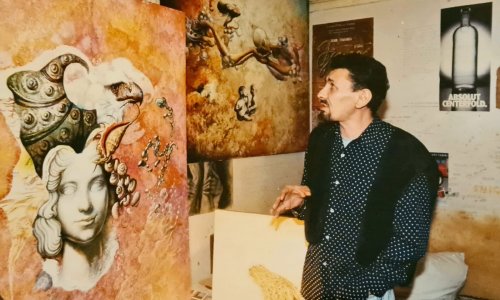Ahead of the upcoming European Games kicking off next month in oil and gas-rich Azerbaijan, local artist community YARAT opens its first permanent space in Baku, the capital. In a local context where complete freedom of expression is still a subculture, the centre opens with The Home of My Eyes, a series of non-political portraits by the celebrated Iranian-American artist Shirin Neshat.
A non-commercial organisation, YARAT (‘to create’ in Azerbaijani) aims to promote local and regional artists locally and internationally and already has 120 projects under its belt so far as well as a commercial outpost, the YAY Gallery. The collective was founded in 2011 by Aida Mahmudova, a talented multimedia Azeri artist and London Central Saint Martin’s art and design school graduate whose first New York solo show opens on 28th May at the Leila Heller Gallery.
Formerly a Soviet industrial building, the new 2000m square contemporary art centre opened last March. Located in a new area looking out onto the Caspian Sea, the centre is surrounded by multiple venues for the Games.
The centre opened with a ground-floor YARAT group show entitled Making Histories and a moving series of photograph portraits, The Home of my Eyes, by the Iranian-American filmmaker and photographer Shirin Neshat and curated by Dina Nasser-Khadivi.
For the artist, who has lived in the United States since 1974 and been living in exile in New York, the theme of home is particularly poignant. "To be invited by Azerbaijan to explore the theme of home for the people here was extremely difficult for me, who hasn’t been allowed back into her country since 1996.”
The highly stylised monochrome portraits of local Azeris are extremely personal and powerful. Moving inside the poetic exhibition under the building’s attic-like roof, it is like stepping inside a chapel adorned with a sea of faces, intense emotion and energy emanating from each pair of eyes. And at the same time, the portraits reflect all the gentle strength of the petite artist whose tender, softly spoken manner is wholly capitvating.
The exhibition isn’t meant to be particularly political, unusually so for Neshat whose works like Women of Allah (1993-96), Women Without Men (2009) and Our House is on Fire (2013) highlight a need for freedom in repressive regimes that could be likened to Azerbaijan where freedom of speech and freedom of the press are restricted.
Neshat’s The Home of My Eyes series highlights individuality; it is a patriotic patchwork of diversity that comes together to paint a picture of unity – but not uniformity. "For me, everyone is an important monument,” says the artist. The artist hopes that this series of portraits will serve to bring the people of Azerbaijan together. "Being shown in this first exhibition of the centre is something the people of Azerbaijan can be proud of, that allows them to be proud of their roots.”
Geographically part of Central Asia, the culturally rich and diverse Azerbaijan sits on the edge of the Caspian Sea and shares borders with Russia, Georgia, Turkey and Iran. A baffling crossroads of cultures, languages and religions, Azerbaijan is predominantly Muslim although secular.
Held in the iron grip of the Soviet Union from 1920, it gained independence in 1991 just before the dissolution of the USSR. Today, Azerbaijan considers itself a democratic country despite controversy surrounding each election. The president in power is Ilham Heydar oglu Aliyev of the New Azerbaijan Party, which, according to Human Rights Watch is guilty of autocracy and various human rights abuses including censorship when it comes to freedom of speech and freedom of the press.
Historically, art has always been of key importance in Azerbaijan. Dubbed the ‘Paris of the East’ in the 19th century, it was the first country in the region to establish an art school, as well as opera houses and theatres. And like the media, art is a key vehicle for expression and freedom but the current regime can be an obstacle. For instance, the most memorable example of the government censoring artistic expression was at the Venice Biennale in 2011, when the Ministry of Culture forced the curator of the Azerbaijan pavilion to cover up statues by Azeri artist Aidan Salkhova that depicted a veiled woman and the Kaaba, the black stone of Mecca sacred to Muslims.
When I sit down with Mahmudova, she is evasive on the subject of how Azerbaijan’s politics interferes with art and affirms that "Artists can express what they like. I do not interfere.” The YARAT founder insists on the collective’s independence from the state – despite her connection as the first lady’s niece – in that it is funded by a bank rather than the government.
"People think that just because of my relations, it affects our independence. But staying independent is very important to me. Even if we have technical support from the government – they allow us to rent spaces and to obtain permission for the various events we have done – we are not funded by the government.”
The issues proved difficult to discuss in any more depth, especially with YARAT’s public relations representative jumping in at will to answer questions directed at the artist, which only further highlights the sensitivity of the matter concerning freedom of expression.
However, to Aida Mahmudova’s credit YARAT is a grass-roots collective that formed organically and while I felt it was tricky for her to express views that could be deemed controversial with regards to her country’s political situation, I felt there was hope for change.
Art in Azerbaijan is traditionally anchored in history and crafts but YARAT opens doors to exploring beyond these confines. In founding the collective, Aida Mahmudova was inspired by the work of Leyla Akhundzadeh who created the Wings of Time art association, which sadly didn’t come to fruition due to the founder’s sudden passing away. Although Mahmudova admires this starting point very much, YARAT is different in that it was created by artists for artists, "she (Leyla Akhundzadeh) had a historical approach, whereas we are coming from an artist’s perspective,” she explains.
Prior to the opening of the new art centre, I made my way to the artists’ studios located in a concrete Soviet style block on a residential backstreet of the capital. And there wasn’t a traditional carpet in sight. Through their work, the artists express a general fracture in society and in the individual (which they did not say is specific to Azerbaijan) like Ramal Kazim and his dark tortured figures twisted in anguish ripping their flesh apart or highly skilled YARAT founding artist Rashad Alakbarov’s clever metal and light sculptures that project wry phrases like ‘This is not chaos’ and ‘All that glitters is not gold’.
Also a founding artist of the collective is world-renown enfant terrible Faig Ahmed who experiments with the traditional Azerbaijani carpet-weaving craft by taking carpets apart as though dissecting history to bring meaning to the present where tradition is fast being cast aside.
(Forbes)
www.ann.az
Follow us !











